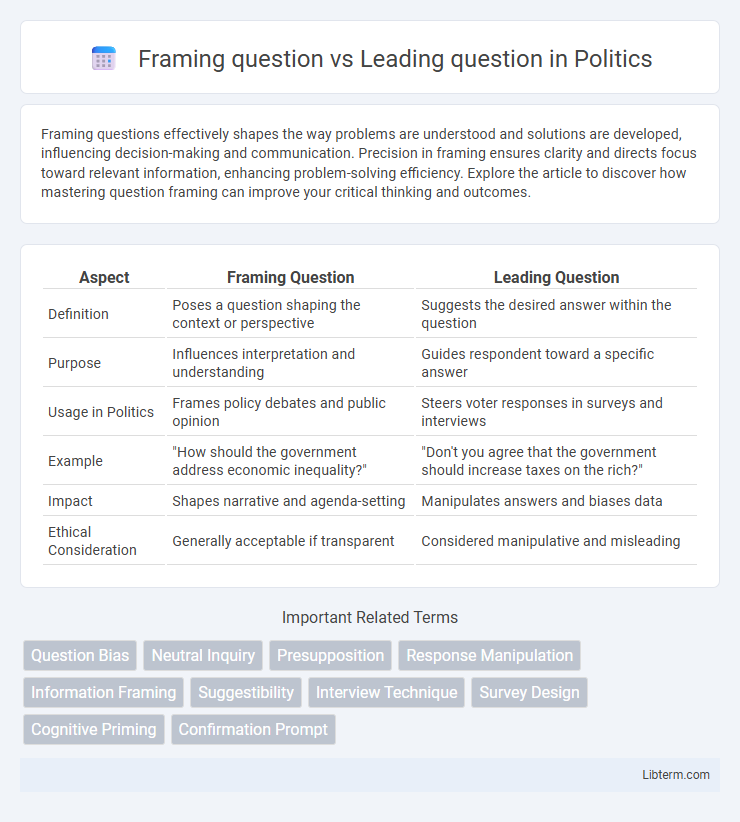Framing questions effectively shapes the way problems are understood and solutions are developed, influencing decision-making and communication. Precision in framing ensures clarity and directs focus toward relevant information, enhancing problem-solving efficiency. Explore the article to discover how mastering question framing can improve your critical thinking and outcomes.
Table of Comparison
| Aspect | Framing Question | Leading Question |
|---|---|---|
| Definition | Poses a question shaping the context or perspective | Suggests the desired answer within the question |
| Purpose | Influences interpretation and understanding | Guides respondent toward a specific answer |
| Usage in Politics | Frames policy debates and public opinion | Steers voter responses in surveys and interviews |
| Example | "How should the government address economic inequality?" | "Don't you agree that the government should increase taxes on the rich?" |
| Impact | Shapes narrative and agenda-setting | Manipulates answers and biases data |
| Ethical Consideration | Generally acceptable if transparent | Considered manipulative and misleading |
Introduction to Framing and Leading Questions
Framing questions shape respondents' perception by presenting information in a specific context, influencing their interpretation and answers. Leading questions suggest a particular response through biased wording or tone, often steering participants toward a desired outcome. Understanding the distinction between framing and leading questions is crucial for designing unbiased surveys and obtaining reliable data.
Defining Framing Questions
Framing questions shape the context and perspective through which information is interpreted, guiding respondents to consider specific aspects of a topic without suggesting a particular answer. These questions set the boundaries and approach for inquiry, influencing how issues are perceived and discussed. Understanding framing questions is essential for effective communication, ensuring clarity while avoiding bias inherent in leading questions.
What Are Leading Questions?
Leading questions are designed to influence a respondent's answer by suggesting a particular response or containing assumptions that guide their reply. They often contain biased or loaded language that limits objectivity and can distort the accuracy of information gathered in surveys, interviews, or legal settings. Understanding the impact of leading questions is crucial for improving the validity of research data and ensuring fairness in courtroom examinations.
Key Differences Between Framing and Leading Questions
Framing questions shape the context and influence how information is interpreted by presenting choices with a particular bias, while leading questions suggest a specific answer by embedding assumptions within the query. Framing questions primarily affect decision-making by emphasizing certain aspects without dictating responses, whereas leading questions guide respondents toward predetermined answers, often compromising objectivity. Understanding these distinctions is essential in research and communication to avoid bias and elicit genuine, unbiased responses.
The Psychological Impact of Question Framing
Question framing significantly influences respondents' cognitive processing and emotional responses, altering decision-making and attitude formation. Framing questions with positive or negative connotations can elicit different psychological reactions, such as optimism or fear, shaping perception and memory recall. Leading questions, by suggesting specific answers, increase the risk of bias and misinformation, impacting judgment accuracy and the reliability of collected data.
How Leading Questions Influence Responses
Leading questions significantly influence responses by suggesting a particular answer, often causing respondents to confirm the implied perspective. This effect can introduce bias, reducing the accuracy and reliability of data collected in surveys and interviews. Understanding the subtle cues in phrasing helps minimize unintentional persuasion and ensures more authentic, unbiased answers.
Examples of Framing Questions vs Leading Questions
Framing questions shape the context to influence how information is perceived, such as asking, "How satisfied are you with our new product's features?" which sets a neutral tone for feedback. Leading questions suggest a desired answer, for example, "Don't you agree that our new product's features are impressive?" pushing respondents toward affirmation. These distinctions impact data collection accuracy by either promoting unbiased responses or introducing response bias.
The Role in Surveys and Interviews
Framing questions shape respondents' perceptions by highlighting specific aspects or contexts, influencing how answers are interpreted in surveys and interviews. Leading questions guide respondents toward a particular response, often biasing results by suggesting an expected or desirable answer. Both play critical roles in data collection, impacting the reliability and validity of findings by affecting how information is elicited and understood.
Best Practices for Constructing Neutral Questions
Framing questions shape respondents' interpretation by highlighting certain aspects, while leading questions suggest a preferred answer, potentially biasing responses. Best practices for constructing neutral questions include using clear, simple language, avoiding emotionally charged or loaded terms, and ensuring questions do not imply judgment or expected responses. Testing questions through pilot surveys helps identify unintended bias, promoting more accurate and reliable data collection.
Conclusion: Choosing the Right Question Type
Framing questions carefully controls the context, steering the respondent's interpretation and affecting how information is processed. Leading questions suggest a desired answer, potentially biasing responses and compromising data reliability. Selecting the appropriate question type depends on balancing clarity, neutrality, and the goal of eliciting honest, unbiased information for valid conclusions.
Framing question Infographic

 libterm.com
libterm.com